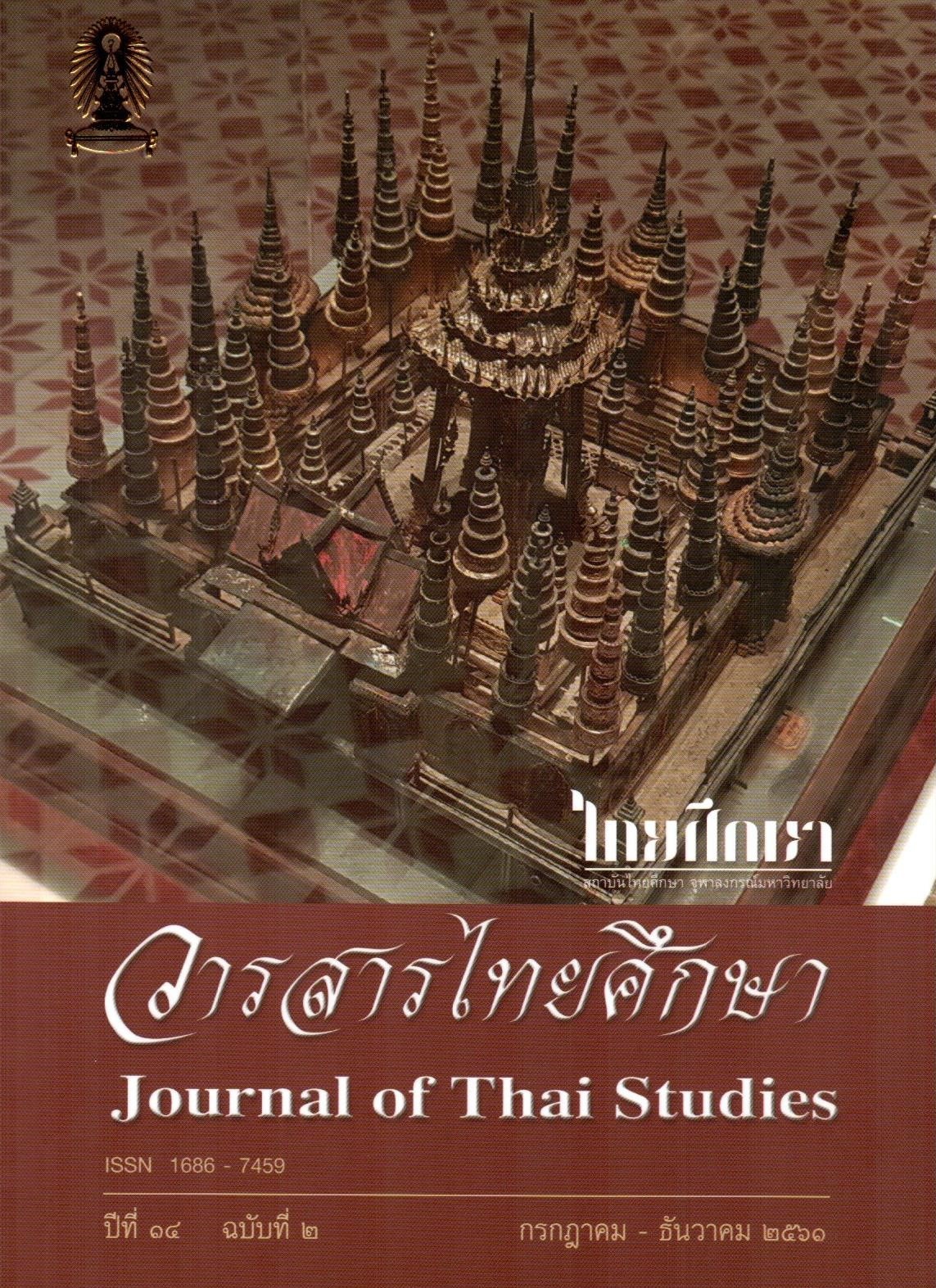The Golden and Silver Flowers – The Tributary Flowers: from a Symbol of Friendship to a Representation of Authority
Main Article Content
Abstract
When discussing tributary offerings that appeared in historical records in the tributary state period, many may think of “golden and silver flowers or trees”, despite the fact that there were other kinds of the tributes that the tributary states offered to Siam, such as produce, local products, weapons and other economically valuable objects. It can be said that golden and silver flowers were construed as a symbol or a representation of political unevenness between the superior and the inferior states. Nevertheless, golden and silver flowers were more significant than being only a tribute – they became items of worship to religious objects and places, symbolizing becoming a Buddhist. They were later a gift or a tribute to felicitate the birth of a prince or princess, symbolizing the growth of the tree. They were also used for the sake of showing gratitude or royalty to the monarchy and for bartering commodity between countries. Finally, they were used in accolades or aggrandizement of the nobility or the investiture of a royal title. They also influenced Thai royal-court performing arts and literature.
Downloads
Article Details

This work is licensed under a Creative Commons Attribution-NonCommercial-NoDerivatives 4.0 International License.
Journal of Thai studies is licensed under a Creative Commons Attribution-Noncommercial-NoDerivatives4.0 Intenational (CC BY-NC-ND 4.0) licence, unless otherwise stated. Plese read our Policies page for more information on Open Access, copyright and permissions.
References
เอกสารภาษาไทย
กล้วยไม้ แก้วสนธิ. (๒๕๕๘). ฟอลคอนแห่งอยุธยา. กรุงเทพฯ : สำนักพิมพ์เอโนเวล.
กรมศิลปากร. (๒๕๔๒). เมืองประเทศราชของสยามในสมัยรัตนโกสินทร์. กรุงเทพฯ : เอดิสัน เพรส โพรดักส์ จำกัด.
คณะสงฆ์วัดพระเชตุพนวิมลมังคลาราม. (๒๕๕๒). พระราชพงศาวดารกรุงรัตนโกสินทร์ รัชกาลที่ ๑ ฉบับเจ้าพระยาทิพากรวงศมหาโกษาธิบดี. กรุงเทพฯ: อมรินทร์พริ้นติ้ง แอนด์ พับลิชชิ่ง.
“ครั้งแรกวัดพระแท่นศิลาอาสน์โชว์ต้นไม่เงินต้นไม้ทอง”. ข่าวสด ฉบับวันที่ ๑๖ ตุลาคม ๒๕๕๙.
จรรย์สมร ผลบุญ. (๒๕๕๗). การสร้างสรรค์ชุดการแสดงจากประวัติศาสตร์ : ประเพณีถวายดอกไม้เงิน ดอกไม้ทอง. มหาวิทยาลัยราชภัฏสงขลา.
จักรพงษ์ คำบุญเรือง. (๒๕๕๙). จากอาณาจักรบ้านนาสู่เมืองเชียงใหม่. เชียงใหม่: โรงเรียนวัฒโนทัยพายัพ.
จัตวา กลิ่นสุนทร. (๒๕๕๙). สถาบันพระมหากษัตริย์. มติชนสุดสัปดาห์ ฉบับวันที่ ๔-๑๐ พฤศจิกายน ๒๕๕๙.
จำนงค์ ทองประเสริฐ. (๒๕๔๔). พระพุทธศาสนาในเอเซียอาคเนย์. กรุงเทพฯ: มูลนิธิอภิธรรมมหาธาตุ.
ชัยวัฒน์ มีสัณฐาน. (๒๕๕๙). “ทบทวนความสัมพันธ์ สยาม-มลายู และการเข้ามาของชาวมลายูในภาคกลางของประเทศไทย.” วารสารกึ่งวิชาการ ปีที่ ๓๗ ฉบับที่ ๒ พฤษภาคม-สิงหาคม ๒๕๕๙.
ณัฐา วิพลชัย. (๒๕๕๖). “มองสังคมผ่านภาษาจากวรรณกรรมท้องถิ่นภาคใต้เรื่องพระยาชมพู.” วารสารมนุษยศาสตร์และสังคมศาสตร์มหาวิทยาลัยราชภัฏสุราษฎร์ธานี ปีที่ ๕ ฉบับที่ ๒ หน้า ๑๒๙-๑๕๔.
ธนนท์รัฐ นาคทั่ง. (๒๕๕๘). ประวัติศาสตร์บาดแผลในอาเซียน กับปัญหาเขตแดนรัฐชาติ : สิ่งตกค้างจากการส่งมอบ ๔ รัฐมลายูให้แก่อังกฤษ ค.ศ. ๑๙๐๙. ชลบุรี: คณะวิทยาศาสตร์และศิลปศาสตร์ มหาวิทยาลัยบูรพา.
ธเนศ อาภรณ์สุวรรณ. (๒๕๕๔). จากระบบบรรณาการถึงการปกครองแบบพิเศษในปะตานี. วิทยาลัยนานาชาติปรีดี พนมยงค์ มหาวิทยาลัยธรรมศาสตร์.
บังอร ปิยะพันธุ์. (๒๕๔๙). ประวัติศาสตร์ไทย การปกครอง สังคม เศรษฐกิจและความสัมพันธ์กับต่างประเทศก่อนสมัยสุโขทัยจนถึง พ.ศ. ๒๔๗๕. นครปฐม: มหาวิทยาลัยราชภัฏนครปฐม.
บาร์บารา วัตสัน และลีโอนาร์ด วาย. อันดายา. (๒๕๕๗). ประวัติศาสตร์มาเลเซีย. กรุงเทพฯ: มูลนิธิโครงการตำราสังคมศาสตร์และมนุษยศาสตร์.
พินธกร นามดี. (๒๕๕๗). การศึกษาความสัมพันธ์ระหว่างสยามกับรัฐมลายูในสมัยรัตนโกสินทร์ตอนต้น (พ.ศ. ๒๓๒๕-๒๓๙๔). กรุงเทพฯ: คณะมนุษยศาสตร์ มหาวิทยาลัยรามคำแหง.
ไมเคิล ไรท์. (๒๕๔๒). ฝรั่งอุษาคเนย์. กรุงเทพฯ: สำนักพิมพ์มติชน.
สมศักดิ์ ฤทธิ์ภักดี. (๒๕๕๖). ต้นไม้ทองต้นไม้เงินสมัยรัตนโกสินทร์. กรุงเทพฯ : นิทรรศการพลังแผ่นดิน อัศจรรย์งานศิลป์แผ่นดินสยาม.
สมาคมนักข่าวหนังสือพิมพ์แห่งประเทศไทย. (๒๕๕๕). สามจังหวัดชายแดนใต้สมัยต้นรัตนโกสินทร์ถึงสมัยรัชกาลที่ ๕. กรุงเทพฯ : ศูนย์ข่าวอิศรา.
สินชัย กระบวนแสง และวรรณิสิริ นุ่นสุข. (๒๕๔๕). การศึกษาคติในการบูชาพระบรมธาตุเจดีย์นครศรีธรรมราช วัดพระมหาธาตุวรมหาวิหาร อำเภอเมือง จังหวัดนครศรีธรรมราช: กรณีดอกไม้เงินดอกไม้ทอง. วิทยานิพนธ์ศิลปศาสตรมหาบัณฑิต สาขาวิชาไทยคดีศึกษา มหาวิทยาลัยราชภัฏนครศรีธรรมราช.
สุภัตรา ภูมิประภาส. (๒๕๕๐). “สี่กษัตริยาปตานี: บัลลังก์เลือด และตำนานรักเพื่อแผ่นดิน.” วารสารศิลปวัฒนธรรม ปีที่ ๒๘ ฉบับที่ ๕, หน้า ๗๖-๘๘.
เอกสารภาษาอังกฤษ
Ahmad Abu Hassan. (2017). Perlis Pernah Memberi Bunga Emas Kepada Inggeris. Orang perlis, Malaysia.
Cyril Skinner (1983). A Malay Mission to Bangkok during the Reign of Rama II, Journal of the Malaysian Branch of the Royal Asiatic Society Vol. 56, No. 2 (245) (1983), pp. 135-140.
Ismail, Bakti. (1960). Bunga Emas Golden Flowers: Gift or Tribute (Kelantan). Malaya in History 6, no. 1 (July).
Oot keat gin. (2004). Southeast Asia: A Historical Encyclopedia, from Angkor Wat to East Timor. Santababara California.
Sharom Ahmat. (1984). Tradition and Change in a Malay State: A Study of the Economic and Political Development of Kedah, 1878-1923. MBRAS Monograph no. 12. Kuala Lumpur: Malaysian Branch of the Royal Asiatic Society (MBRAS).
Susan Conway. (2012). The politics of inland Southeast Asia: Tribute Relations in the Nineteenth Century. SOAS, University of London.
Wolters, O.W. (2008). Early Southeast Asia: Selected Essays. Craig J. Reynolds, ed. Ithaca: Cornell University Press.


